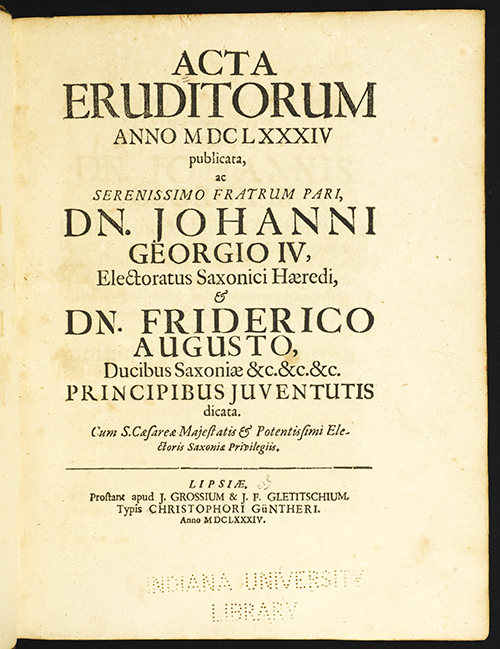- About MAA
- Membership
- MAA Publications
- Periodicals
- Blogs
- MAA Book Series
- MAA Press (an imprint of the AMS)
- MAA Notes
- MAA Reviews
- Mathematical Communication
- Information for Libraries
- Author Resources
- Advertise with MAA
- Meetings
- Competitions
- Programs
- Communities
- MAA Sections
- SIGMAA
- MAA Connect
- Students
- MAA Awards
- Awards Booklets
- Writing Awards
- Teaching Awards
- Service Awards
- Research Awards
- Lecture Awards
- Putnam Competition Individual and Team Winners
- D. E. Shaw Group AMC 8 Awards & Certificates
- Maryam Mirzakhani AMC 10 A Awards & Certificates
- Two Sigma AMC 10 B Awards & Certificates
- Jane Street AMC 12 A Awards & Certificates
- Akamai AMC 12 B Awards & Certificates
- High School Teachers
- News
You are here
Euler and the Bernoullis: Learning by Teaching - Introduction
Introduction
I soon found an opportunity to be introduced to a famous professor Johann Bernoulli... True, he was very busy and so refused flatly to give me private lessons; but he gave me much more valuable advice to start reading more difficult mathematical books on my own and to study them as diligently as I could; if I came across some obstacle or difficulty, I was given permission to visit him freely every Sunday afternoon and he kindly explained to me everything I could not understand … and this, undoubtedly, is the best method to succeed in mathematical subjects. - Leonard Euler [13, p. 90]
Teaching and learning are part of the same process. A common refrain among teachers of mathematics is, “I never really understood this material until I taught it.” Part of the reason for this, of course, is that the repetition and the need to know the material well enough to answer questions solidifies the subject in the mind of the teacher. Another reason is the need to find ways to recast material to make it accessible to learners – to meet them where they are in the process of discovery. Today, the best way to learn mathematics is to teach it. And the best way to teach it is to explore with students how the original innovators learned and taught mathematics by investigating its rich history. This was just as true when modern analysis was getting its start. In the exciting days of the late seventeenth and early eighteenth centuries, after Gottfried Wilhelm Leibniz had opened the floodgates with a short, difficult article on calculus in his own journal, Acta Eruditorum, two generations of Bernoullis and two generations of Eulers were discovering, and teaching each other, the mathematics that made the modern age possible. Through formal and informal tutoring, by way of letters and casual discussion, in the absence of input from universities, they encouraged, challenged, instructed, refuted, and inspired each other.

Figure 1. Title page of the 1684 volume of Acta Eruditorum, the journal Leibniz created, published, and made famous with his first work on calculus, which appeared in this volume. (Courtesy of the Lilly Library, Indiana University. You may use this image in your classroom; all other uses require permission from the Lilly Library. See Leibniz’s three most important papers on calculus in their entirety in Mathematical Treasure: Leibniz’s Papers on Calculus here in MAA Convergence.)
Jakob Bernoulli was the tutor of Paul Euler, the father and tutor of Leonhard Euler (see Note 1). Jakob also taught his younger brother Johann Bernoulli. Johann, as noted above, tutored Euler (see Note 2). Euler in turn befriended and worked with Daniel Bernoulli, the son of Johann. Both Jakob and Johann Bernoulli had learned calculus by reading and corresponding with Leibniz. In a way, Daniel Bernoulli closed a loop when he abandoned his father’s patriotic dislike of Newton and studied both Newtonian and Leibnizian calculus.
In our classrooms today, do we teach using “the best method to succeed,” according to Euler? Do we encourage our students to discover obstacles on their own, and bring them to us? Or do we warn the students of these obstacles beforehand, depriving them of much of the challenge?
Note 1. “I received from my father my first tuition; and because he had been one of the disciples of the world-renowned Jacob Bernoulli, he tried to impart to me the first principles of mathematics, and to this end used Christoph Rudolph’s Coss.” This was the same text Jakob Bernoulli himself had started with! [6, p. 5]
Note 2. In fact, as the opening quotation indicates, Bernoulli refused to make this a formal arrangement because the Eulers could not pay him. Johann’s tutelage consisted of informal discussions and recommendations for reading. See the quote at the beginning of this section. Compare to this passage from John-Jacques Rousseau’s Emile: “There is much discussion as to the characteristics of a good tutor. My first requirement, and it implies a good many more, is that he should not take up his task for reward. There are callings so great that they cannot be undertaken for money without showing our unfitness for them; such callings are those of the soldier and the teacher.” [8]
Paul Bedard (Saint Clair County Community College), "Euler and the Bernoullis: Learning by Teaching - Introduction," Convergence (August 2015), DOI:10.4169/convergence20150801




